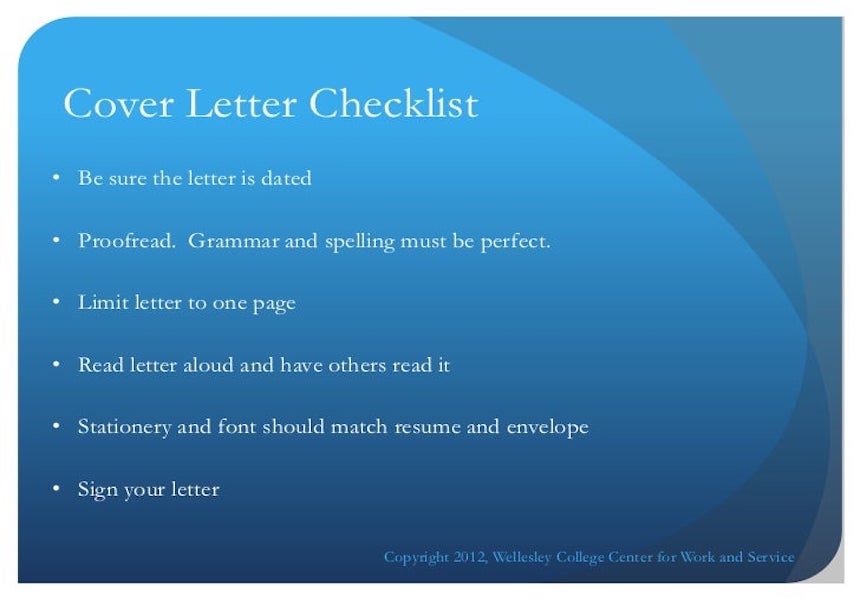Cover Letter Checklist: Must-Haves In A Cover Letter
Like peanut butter and jelly. Cookies and milk. Cover letters and resumes Some things go together.
A cover letter may not be delicious or sweet, but it is still one significant half of a perfect pair when applying for jobs. When applying for a job, a cover letter is a one-page letter that you send along with your resume. It allows you to highlight your skills, interests, and intent, and it is used to supplement the information on your resume, particularly concerning your work experience.
So, You've written your resume and created a cover letter. But how do you ensure that the hiring manager notices all of your efforts? Here are tips on how to PROOFREAD your cover letter.
Tips to Proofread A Cover Letter
Simply including a cover letter isn't enough; it can be a game-changer when used correctly. Here are seven pointers to help you improve your cover letter:
Double-check everyone's contact information;
Check your contact information and the information you have for your potential employer three times. Ensure your phone number and email address are correct, that no numbers or letters are transposed, and that your email address is correct, whether it's in your header, your signature, or both. Include a link to your professional website or portfolio if you have one. After you've confirmed all of your information, go over the company's contact information, double-check the spelling of their name (including "Inc." or "LLC" if applicable), and double-check the address.
Check that you're using the correct greeting;
Begin by assessing your tone. Is it more formal or informal? The appropriate greeting would depend on various factors, including whether or not you know the hiring manager personally if you were referred by an employee, the type of job you are applying for, and the overall company culture. When in doubt, go with the more formal option.
If you've found the hiring manager's name and are addressing them by name in the greeting of your cover letter, double-check the spelling before sending the letter.
Your full contact information is the same as it is on your resume. Include your name, mailing address, phone number, and email address, as well as a link to your LinkedIn profile or personal website if you have one.
A consistent appearance. Make sure the style and presentation of your resume and cover letter are consistent.
Other Sections of a paragraph to Include are:
- A salutation.
- An introduction (one paragraph).
- The main body (one to two paragraphs).
- A conclusion (one paragraph).
- Salutation: (Dear Ms. X). Instead of using To Whom It May Concern, try to get an exact name.
- Opening:
- Introduce yourself briefly.
- Mention the position you're applying for and why you'd be a good fit.
- In a few powerful lines, demonstrate your strengths to the reader.
- Personalization. The letter must begin with a salutation and address the appropriate person.
- Main body:
- Main body:
- Get into the nitty-gritty of how and why you are the best candidate for the job. Examine the qualifications, experience, and skills listed in the job description and demonstrate to the reader how you meet these requirements. Describe some of your most notable past accomplishments. Concentrate on the company's requirements and requirements; try to avoid using "I" statements. When writing this section, always keep the following question in the back of your mind: Why should we hire you?
- The ideal amount of white space—neither too much nor too little.
- Approximately half a page in length (one full page including your contact information and the recipient's).
- To increase your chances of making it through the applicant tracking system, write your critical skills related to the position being applied for in the same way that they are written in the job posting (ATS).
- The reasons why you are the best candidate for the job. Include relevant knowledge, skills, and experience in the job posting.
Final Paragraph
This should summarize what you discussed in the body, reinforcing what you bring to the table. Thank the employer and invite them to a meeting. Sign off professionally and courteously.
Did you provide a simple way for employers to contact you, such as a phone number and an email address?
Is your cover letter concluding with a call to action that confidently requests an interview?
Did you remember to sign it if you're mailing a hard copy? Be sure to triple check
What to Leave Out and Avoid Avoid using cliches like the following:
- "Dear Sir/Madame/Madame/Madame/Madam
- "Hello, my name is..."
- "I'm writing to express my enthusiasm for..."
- "I know I'm not the best candidate, but..."
- "I'm applying for the position of [title] at [Company]..."
- Never use the same cover letter twice. Every time, start from scratch. It's OK to follow a template but never use the same cover letter twice.
- Don't be evasive. Be specific, especially when describing your skills in the position.
Do not rehash your resume. Instead, talk about your work history and highlight any significant accomplishments relevant to the position you're applying for. Expand on specific aspects to tell a story about your accomplishments, but don't tell the reader what they already know.
Hope this helps. If you need help creating a good CV, Check out MyCV Creator.
Cheers!









